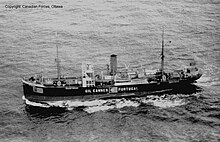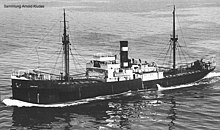Lahneck (ship, 1923)
|
The third Lahneck
|
||||||||||||||||||||||
|
||||||||||||||||||||||
|
||||||||||||||||||||||
|
||||||||||||||||||||||
|
||||||||||||||||||||||
The third Lahneck of the Deutsche Dampfschiffahrtsgesellschaft Hansa (DDG "Hansa"), which came into service in 1923, was, together with the sister ship Stahleck, the smallest new cargo ship built by the shipping company between the world wars. The two small cargo ships built by AG Weser were intended for the Spain-Portugal service.
The Lahneck started at Vigo in 1939 because of the threat of war . It left the Spanish port on November 11, 1939 and reached Hamburg via northern Norway on December 16, 1939.
On March 6, 1942 she was rammed by the company ship Treuenfels in a convoy off Oksöy near Kristiansand and sank.
History of the ship
Shortly before the First World War, DDG "Hansa" received two newbuildings for its Spain-Portugal service: the shipping company's first motor ship, the Rolandseck (1912, 1663 GRT), and the similar, steam-powered second Lahneck (1914, 1775 GRT) ) The name Lahneck after Lahneck Castle near Koblenz was first given in 1882 to a small steamer for the North Sea and Baltic Sea. The 746 GRT ship delivered from Schichau in 1883 stranded at Schiermonnikoog on December 23, 1894 . It was not until the following summer that the first Lahneck was declared unworthy of repair and sold to the Netherlands. Repaired there, the ship sank as a Norwegian Freidig on October 24, 1918 after a collision in the North Sea.
The aforementioned second Lahneck sought refuge in Lisbon in August 1914. Confiscated in February 1916, she entered service under the Portuguese flag as Gil Eannes and was not canceled until 1960.
The new Lahneck of 1663 GRT was the lead ship of two newbuildings for the shipping company's resumed Spain-Portugal service. It was launched in December 1922 and was delivered on January 13, 1923. Like the sister ship, the ship had a length of 77.16 m over all, a width of 11.05 m and a draft of 5.37 m. The three-cylinder, triple expansion engine of 1000 hp delivered by the shipyard enabled the ship to travel at a speed of 10 knots (kn). The new building had a carrying capacity of 2128 dwt and was operated with a crew of 25 men. It could take up to six passengers.
Mission history
The two ships built by AG Weser came into the service of the Bremen shipping company in 1923 and were used on the line to Spain and Portugal, which was reopened in August 1919 with the old Soneck (1902, 1121 BRT), together with the Oldenburg-Portuguese DR (OPDR) was operated. They stayed in their traditional sailing area until the outbreak of World War II. From 1936 this service was reinforced by three more modern steamships as part of the Third Reich's Second Four-Year Plan .
When the Second World War threatened to break out in 1939, the Lahneck called at the Spanish port of Vigo on August 29, 1939 , where she remained until November 11, 1939.
War missions
Superficially camouflaged as the Soviet steamer Dvina , the Lahneck tried to break through to Germany on November 11, 1939. At the same time, the Cordoba of the HSDG (1919, 4611 BRT) and the OPDR freighters Sebu (1921, 1894 BRT), Tangier (1923, 1742 BRT) and Palos (1923, 997 BRT) left the Spanish port. The Lahneck reached the North Cape undiscovered on December 4th and continued her voyage along the Norwegian coast. She reached Hamburg on December 16, 1939. The four other ships from Vigo also made their breakthroughs home.
The ship was then used as a freighter in the North and Baltic Seas and off Norway. On March 6, 1942, the Lahneck was escorted by the outpost boats V 802 , V 803 and V 804 on a trip from Hamburg to Norway with a load of rock salt together with the Treuenfels (1928, 8457 GRT), Adele Traber (1930, 2575 BRT), Ingrid Traber (1927, 1873 BRT), Helga LM Russ (1926, 1709 BRT) and two Swedish steamers off Oksöy near Kristiansand . When the ice went, the Treuenfels, also belonging to the DDG “Hansa”, ran into the Lahneck from aft at an angle of 45 ° . The Treuenfels took over the crew of the sinking Lahneck . The tug Jomsburg and the outpost boat V 803 tried in vain to tow the Lahneck , which soon sank.
The sister ship Stahleck
The operational history of the Stahleck , which came into service on April 5, 1923, is similar to that of its sister ship. In 1939 this ship was at home and at the end of the war, slightly damaged, was confiscated by the British in Kiel . It was repaired at the Bremer Vulkan in the winter of 1945/46 and handed over to the Netherlands in August 1946. Initially as Aardenburg , from 1946 as Danae , the ship was then in the service of Koninklijke Nederlandsche Stoomboot Maatschappij NV until October 1953. Then sold to Greece, the Danae lying in Djibouti was sold to a local shipowner in 1963. In 1965 the ship sank in shallow water. The ship was lifted again from October 1965 in Massaua .
Seagoing vessels of the DDG "Hansa" under 3000 GRT (1882-1939)
| Surname | Shipyard | GRT tdw |
Launched in service |
further fate |
|
Soneck (2) |
Wigham & Richardson building no. 388 |
1121 1643 |
February 25, 1902 February 18, 1902 |
72.40 m, during World War ore and coal voyage on the North and Baltic Seas, at times coal ship XVIII of the Imperial Navy , 1919 the only remaining seagoing ship of the DDG "Hansa", 1932–35 Latona of DG Neptun , sold to the Navy in August 1936 , test ship Strahl Sunk on the transfer to Great Britain, February 2, 1949 |
|
Trostburg (2) |
Nüscke & Co . Construction no. 245 |
1467 2400 |
08.1918 November 6, 1919 |
81.12 m, under construction for DG Argo during the World War , chartered by DDG "Hansa" in 1919, returned to DG Argo in 1923 / merged with Roland-Linie , renamed Pera , in 1926 by merging to form NDL , October 30, 1926 at Messageries Maritimes sold, renamed Le Myre de Vilers , from 1928: Governor Général Paul Doumer , from 1938: Laos , sunk on October 11, 1942 in the Gulf of Tongking during a typhoon : |
|
Rolandseck (3) ex Florence |
Flensburg building no. 250 |
1826 2631 |
August 26, 1905 December 13, 1921 |
85.34 m, built as Florence for Sloman , delivered to Great Britain in 1920, December 13, 1921 purchase by DDG "Hansa", December 1932 sold to DG Neptun as Saturn , 1937 to the Borchardt shipping company : Lucy Borchardt , 1938 with the shipping company to Great Britain , 1939 ammunition storage ship, demolished in 1951 |
|
Lahneck (3) |
AG Weser Building No. 337 |
1663 2128 |
12.1922 13.1.1923 |
77.16 m, 1939 refuge in Vigo , from 11 November 1939 breakthrough in the home on the North Cape , (4.12.) On 16 December 1939 in Hamburg on March 6, 1942. Oksöy near Kristiansand after collision with the Treuenfels dropped |
|
Steel corner (3) |
AG Weser Building No. 338 |
1663 2128 |
03.1923 5.4.1923 |
77.16 m, from 1939 North and Baltic Sea voyage, from November 1945 repaired at the Bremer Vulkan, 1946 to the Netherlands: Aardenburg , 1946: Danae , sold to Greece in 1953, 1963 trailer in Djibouti, sunk in 1965; lifted and broken off |
| Rolandseck (4) |
Oderwerke building no. 792 |
1845 2970 |
23.11.1936 08.02.1937 |
90.9 m, December 1938 to March 1939 after stranding repair in Spain, at the beginning of the war in Vigo, from October 10, 1939 breakthrough home via Norway, on November 1, 1939 in Hamburg, on March 12, 1945 on the journey to Aarhus loaded with 417 soldiers, 116 horses and other equipment attacked by machines of the 58th Squadron ( RAF ), sunk near Skagen after being hit by bombs |
|
Soneck (3) |
Seebeck building no. 597 |
2191 3080 |
4.6.1938 July 16, 1938 |
93.04 m, September 1939 in Padang , confiscated by the Dutch authorities in May 1940: Karsik , 1948 conversion. Stranded and repaired in 1950, Pearl of Victoria (Panama) in 1963 . Accumulated, broken and broken off in the Red Sea on June 9, 1967 |
| Schwaneck |
Seebeck building no. 617 |
2194 2985 |
4.3.1939 1.6.1939 |
100.05 m, intended as a transporter for sea lions, sank on November 17, 1941 on a trip from Norway to Memel with pebbles in the Pomeranian Bay after being hit by a mine. |
Individual evidence
- ↑ Schmelzkopf: Die Deutsche Handelsschiffahrt , p. 202 ff.
- ↑ 21-27 November 1939 North Atlantic
Web links
literature
- Hans Georg Prager: DDG Hansa - from liner service to special shipping , Koehlers Verlagsgesellschaft, Herford 1976, ISBN = 3-7822-0105-1
- Reinhardt Schmelzkopf: German merchant shipping 1919–1939. Volume 1: Chronicle and evaluation of the events in shipping and shipbuilding. Gerhard Stalling, Oldenburg 1974, ISBN 3-7979-1847-X .
- Reinhold Thiel: The history of the DDG Hansa. Volume 1: 1881-1918. HM Hauschild, Bremen, 2010, ISBN 3-8975-7477-2


